#Full Article
Text


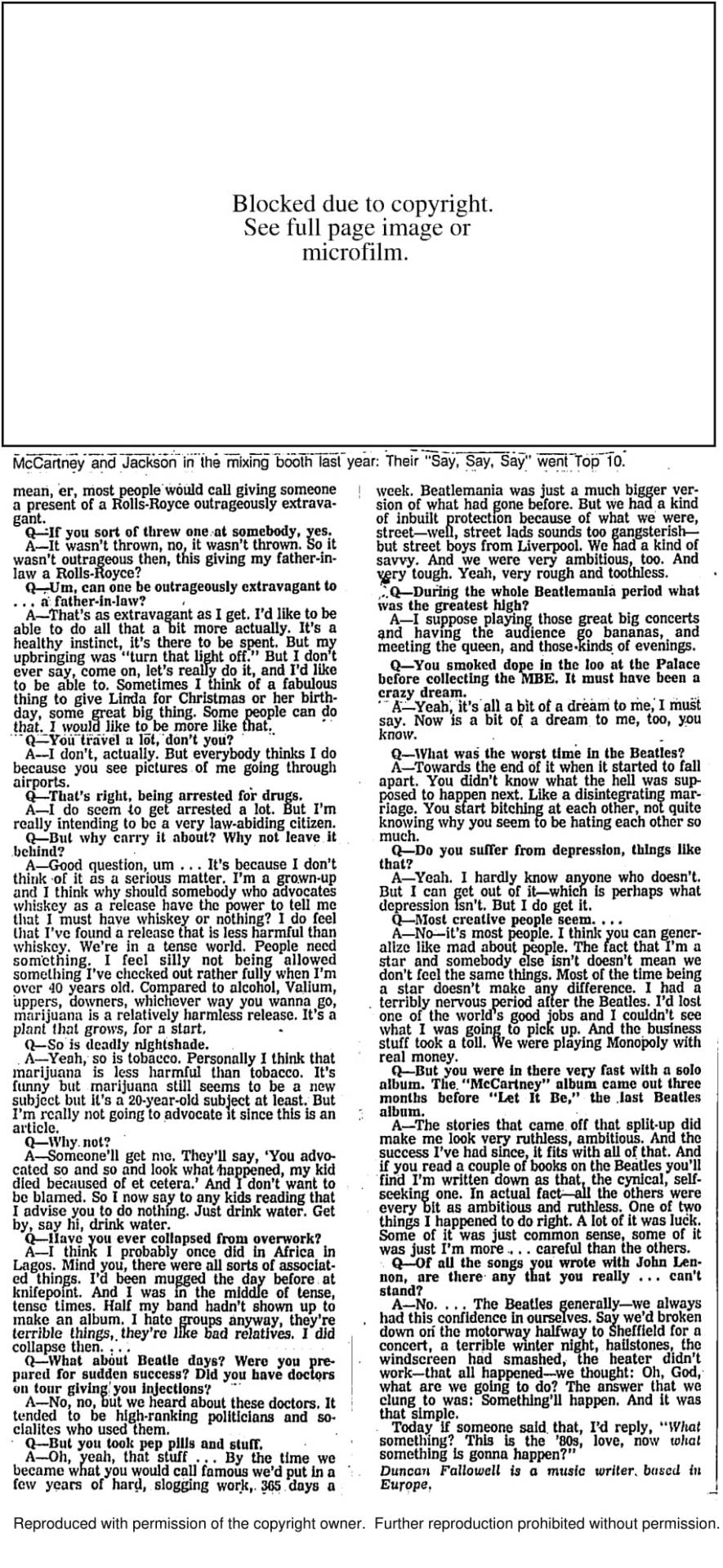
Paul McCartney today? A content and wealthy daddy. Interview by Duncan Fallowell in the Chicago Tribune. October 14th, 1984.
#someone asked for the full interview#here you go#he’s abnormally direct#he mentions almost dying twice#paul mccartney#my quotes#full article#my articles
73 notes
·
View notes
Text

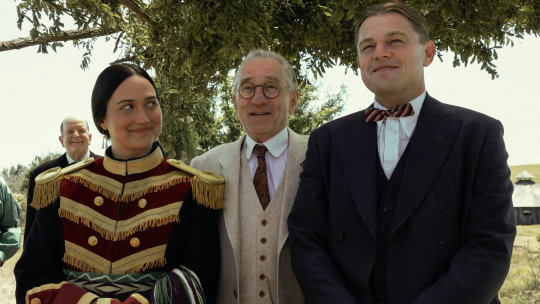
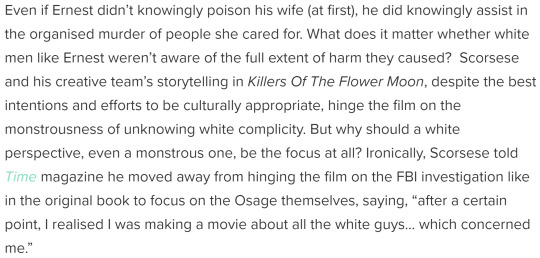

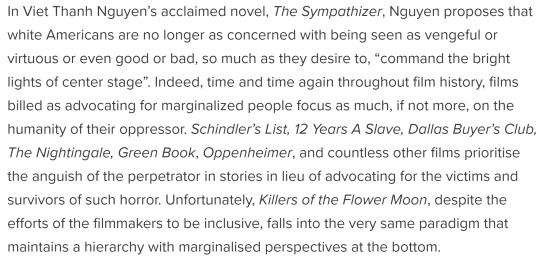


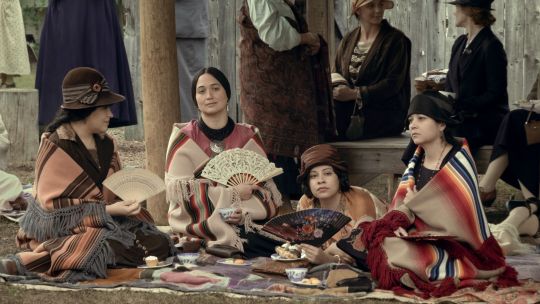

READ THE FULL ARTICLE HERE
‘Killers Of The Flower Moon’ Can’t Escape Its Own White Gaze by Merryana Salem / Killers Of The Flower Moon (2023). Dir. Martin Scorsese
#killers of the flower moon#martin scorsese#lily gladstone#indigenous#media representation#writing#read the full article if you can guys my editors are looking for any excuse to claim i am not good at my job rn#/
2K notes
·
View notes
Text
This has been an absolutely horrible couple weeks for the Jewish and Israeli community, so I want to throw in at least a tiny bit of hope in here. Amina Hassouna, the Bedouin girl who was severely hurt in Iran’s missile attacks, has been recovering well and seems to be in good condition! She is described as being ‘fully conscious’ and ‘communicating and smiling’. Two bomb shelters have been placed in Al-Fura, the town that she and her family are from, as well.
#ישראבלר#ישראל#jumblr#(I know technically it’s not but I think people will be happy to see this)#also#putting this in the tags— I don’t want to focus on politics because this news is more important right now#but I do truly hope that this will initiate stronger moves towards protecting Bedouin towns and villages#many of them are unrecognised and do not have bomb shelters despite being there for decades#the treatment of Bedouins by the government in general needs to vastly improve#hopefully there will be proper steps in the future towards improving conditions for these towns#like I’m trying to be mild about this because it’s a subject that makes me very upset and I don’t want to go on an angry rant lol#like I said— hopefully things’ll to start change in a few years if the next government can please form a coalition not full of crazy people#if you want to read more about Amina and her family the Times of Israel has quite a few articles btw
433 notes
·
View notes
Photo
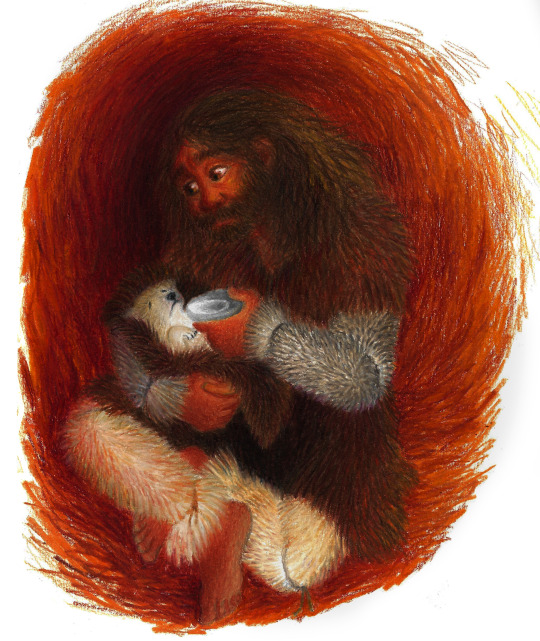
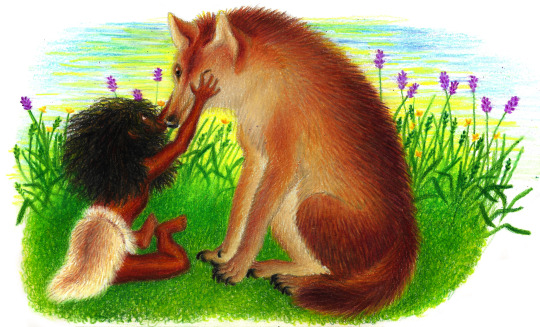
Paleolithic humans
Been meaning to make art of early humans for a while and these in particular were greatly inspired by this article:


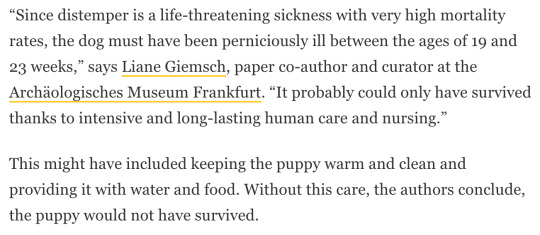

#ask to tag#these are just bits of the article go to the link to read the full thing#the look of the dogs is prob not very accurate lol i tried to go for something wolf-like but clearly not a wolf#i imagine there were prehistoric dogs that would be patient with children back then. hence the second illustration :)#art#illustration#colored pencil#paleolithic#dogs#animal death
5K notes
·
View notes
Text
"The world's coral reefs are close to 25 percent larger than we thought. By using satellite images, machine learning and on-ground knowledge from a global network of people living and working on coral reefs, we found an extra 64,000 square kilometers (24,700 square miles) of coral reefs – an area the size of Ireland.
That brings the total size of the planet's shallow reefs (meaning 0-20 meters deep) to 348,000 square kilometers – the size of Germany. This figure represents whole coral reef ecosystems, ranging from sandy-bottomed lagoons with a little coral, to coral rubble flats, to living walls of coral.
Within this 348,000 km² of coral is 80,000 km² where there's a hard bottom – rocks rather than sand. These areas are likely to be home to significant amounts of coral – the places snorkelers and scuba divers most like to visit.
You might wonder why we're finding this out now. Didn't we already know where the world's reefs are?
Previously, we've had to pull data from many different sources, which made it harder to pin down the extent of coral reefs with certainty. But now we have high resolution satellite data covering the entire world – and are able to see reefs as deep as 30 meters down.

Pictured: Geomorphic mapping (left) compared to new reef extent (red shading, right image) in the northern Great Barrier Reef.
[AKA: All the stuff in red on that map is coral reef we did not realize existed!! Coral reefs cover so much more territory than we thought! And that's just one example. (From northern Queensland)]
We coupled this with direct observations and records of coral reefs from over 400 individuals and organizations in countries with coral reefs from all regions, such as the Maldives, Cuba, and Australia.
To produce the maps, we used machine learning techniques to chew through 100 trillion pixels from the Sentinel-2 and Planet Dove CubeSat satellites to make accurate predictions about where coral is – and is not. The team worked with almost 500 researchers and collaborators to make the maps.
The result: the world's first comprehensive map of coral reefs extent, and their composition, produced through the Allen Coral Atlas. [You can see the interactive maps yourself at the link!]
The maps are already proving their worth. Reef management agencies around the world are using them to plan and assess conservation work and threats to reefs."
-via ScienceDirect, February 15, 2024
#oceanography#marine biology#marine life#marine science#coral#coral reefs#environment#geography#maps#interactive maps#ai#ai positive#machine learning#conservation news#coral reef#conservation#tidalpunk#good news#hope#full disclosure this is the same topic I published a few days ago#but with a different article/much better headline that makes it clear that this is “throughout the world there are more reefs”#rather than “we just found an absolutely massive reef”#also included one of the maps this time around#bc this is a really big deal and huge sign of hope actually!!!#we were massively underestimating how many coral reefs the world has left!#and now that we know where they are we can do a much better job of protecting them
429 notes
·
View notes
Text
Police kill another black man via suffocation.
426 notes
·
View notes
Text
INTERVIEW: Lottie Tomlinson: we lost our mum and sister. Louis saved me
At the age of 20, the sister of One Direction singer Louis had already lost her mother, Johannah, and sister Félicité. Now 25, the social media star has written a book about how they coped
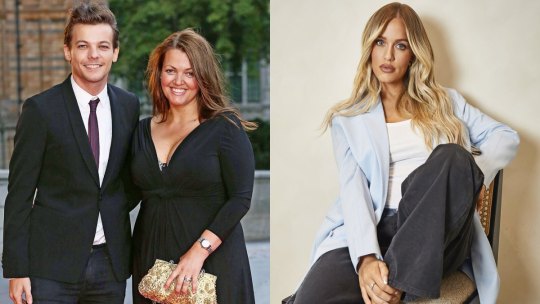
Alice Thomson | Tuesday July 23 2024, 5.00pm BST, The Times
Losing Mum was so hard. I was only a teenager but at least I knew that her death was a possibility, even though she didn’t accept it. She was 47 and had cancer. But when my sister died three years later, I was on this hotel balcony in Bali and I was screaming, ‘No, my baby sister, no.’ The pain was indescribable. I kept thinking, ‘Why me? This can’t be happening again. When is this going to end?’ ”
We are sitting on Lottie Tomlinson’s immaculate white sofa in her pristine white house in Chislehurst, southeast London, where she is curled up in tiny shorts with a perfect tan and impeccably applied make-up. But her French manicured nails are digging so hard into the sofa I think they might snap, the heart tattoo on her minuscule wrist is throbbing and her eyelashes are clogged with tears.
Her life sounds blessed. The influencer has 4.8 million Instagram followers waiting for her to dispense advice on how to apply mascara; the fake tan brand, Tanologist, that she launched at 19 has gone global; and she has a devoted fiancé, Lewis Burton, who runs a luxury concierge business and whose former girlfriend was the late Caroline Flack. They have an adorable son called Lucky, who is dripping ice cream on her marble counters. Her new book is also called Lucky Girl; her older brother is Louis Tomlinson of One Direction and she was touring the world with the band as a make-up artist at 16.
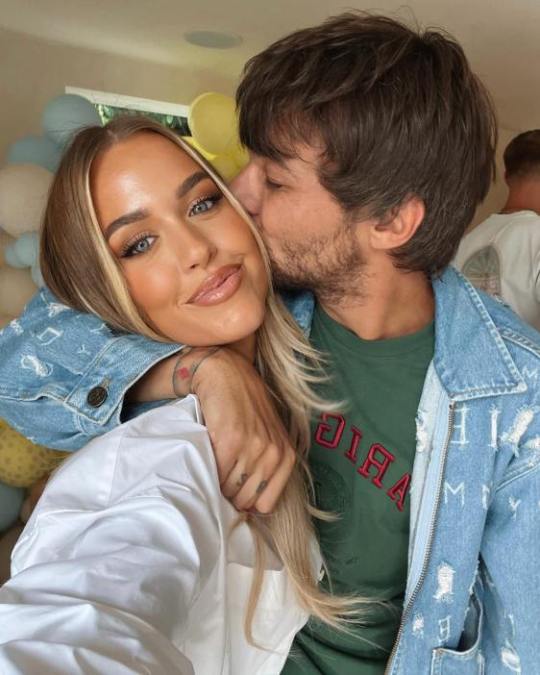
But after her mother died when she was 18, Tomlinson was left looking after her younger sister and two sets of twin siblings, aged eight and two, while creating her businesses, and trying to process her grief. Her father had left their home in Doncaster years before after a battle with alcohol. “Dad had a drinking problem. We’d see glimpses of his good side but he let us down,” she says. “I ended up trying to take care of him rather than the other way round.”
When her mother died, life felt bleak, “I lost the one person who loved me unconditionally, and then when my sister Fizz [Félicité] died of an accidental overdose, I thought I could never be happy again,” she says. “I found the lead-up to Mother’s Day devastating without my sister as well. It was a constant reminder that I was now different from my friends. In my dreams, my mum was still there; she was alive. I woke up feeling comforted, only to realise that she’d gone.”
Tomlinson, who is now 25 and a patron of the bereavement charity Sue Ryder, moves easily between telling you how to apply the best tan and how to talk about death. She cares passionately about both subjects and takes them equally seriously, worried that I’ve never tried a bronzer or used foundation before asking how I coped when my mother died during the pandemic. Her soft Yorkshire accent is both reassuring and no-nonsense.
Born near Doncaster, she was only two when Fizz was born and six when the first twins arrived. “I’ve always been the big sister — Fizz and I each got one and then more twins six years later.” While Louis had his own space, the girls all shared one room with bunk beds. “It was chaos, but my mum, Johannah, was a midwife and loved being pregnant and having so many babies,” she explains. “I used to be in awe of the way she could feed the twins at once, one on each hip. She would do the night shifts, while I held the fort at home.”
Within a few years, Tomlinson would be touring America, Asia and Europe, flying first class with Louis, part of the biggest boy band in the world, but until she was 15, the family had only ever gone to France once a year all packed into a seven-seater car, with her mother’s new partner, snacks laid out in the middle. They stayed in a caravan park. On a Sunday, a treat was to go to their mother’s hospital to see the babies.
While Louis just wanted to sing, play the guitar and listen to Oasis, the girls were obsessed with make-up. ��From the age of 12, I struggled academically, but I loved cropped clothes and my mum’s highlighters and mascaras.” She learnt how to apply everything from YouTube tutorials, rather than doing algebra. “We didn’t have much money — we sometimes couldn’t afford to top up the electricity meter so used candles — but everything my mum earned she spent on us. We all looked immaculate — I remember her being horrified when I dyed my hair orange. So it was lovely later when we could treat her.”
Saturday nights were spent watching The X Factor. “My mother and brother kept applying; in 2010, he got in and the whole family went for the audition. We believed in him, but we never thought it would go that far.” One day the family were going to the live shows, the next the boy band was formed with Harry Styles, Zayn Malik, Niall Horan and Liam Payne. “He was 18. For my mum it was a big shock. It was all so sudden. The press and fans were in our front garden every day.”
The older twins had already made their first TV appearances — they sound like Doncaster’s Von Trapps. “My mother was gently pushy,” Tomlinson says, smiling at the thought. “When I didn’t get good enough GCSEs to stay at school, she sent me off to join Louis on tour as work experience. I was so scared. I remember her ringing up Lou [Teasdale], their hair and make-up artist, and saying, ‘Lottie has not got through to sixth form; she’s going to come and assist you.’ I was in the car going, ‘No, please don’t.’ But it ended up being the best thing that happened to me. I went for a week and stayed two years. Lou and I are still so close.”
Suddenly, the two eldest Tomlinson children were circling the world, eating room service and ducking the paparazzi hanging out of helicopters taking snaps. “At first Louis didn’t really want his little sister gate crashing his new rock-star life, but now it feels like the best time of our lives — we experienced that craziness together,” she says.
The teenage Tomlinson found it harder to cope with being photographed wherever she went. “I had some puppy fat which made me very self-aware, and the filler culture was coming in and I felt I had to look perfect.” She had her lips done first at 17. “Then I became addicted: cheek filler, jaw filler, more make-up, blonder hair, slimmer and more tanned. My mum thought I looked perfect, but I was always searching.”
Five years later, when she became pregnant with Lucky and her lips started to swell and crack, she realised she didn’t need the enhancements any more. “I had everything removed, the false eyelashes too. It was liberating.” She kept her boob job, however. “That was just enhancement,” she says laughing. “The rest radically changed the way I looked. My breasts also got huge when I was pregnant and it was a bit painful. But I still breastfed. I loved carrying my child. I felt fantastic even when I was sick and exhausted.”
She leans forward, wraps her bronzed arms around her stomach and whispers, “I am pregnant again. We don’t know yet if it’s a boy or girl. It’s only 13 weeks, so this is the first time I’ve said it publicly. I think I want a big family. I loved having Lucky but after a year I wanted to give him siblings.”
Tomlinson’s influencer career began once she established herself on tour. Soon everything she did, even dying her roots rainbow-coloured, went viral and fashion companies from Asos to Dior wanted in on it. “I was just going for it. I couldn’t believe the money I was making and spending — money I didn’t know existed as a child.”
Then suddenly her mum came home from holiday with flu. “She didn’t want to get out of bed. The doctors quite quickly told her she had leukaemia and she went straight to London for treatment. It all happened so fast. I remember being in London at work and getting a call from her partner — she couldn’t say the words herself, it was too hard for her.” The family were told it was treatable. “We kept so much hope.”
Her mother asked the family to keep her illness secret. “It was hard because you feel so isolated, but I understood. Louis was in the public eye and she didn’t want him questioned. She was determined to fight it and didn’t want everyone pitying her. My friends noticed I was acting differently for a few months. But I wanted to respect her wishes. It was her one request.”
She also dropped everything to go back to Doncaster to help her grandparents with the twins. “The younger ones were two and I wanted to keep everything as normal as possible. I can’t imagine what my mum was feeling leaving her kids to go to hospital.
“I would take them down and treasure seeing her — we tried to keep it light, no serious conversation. The only way Mum could cope was to keep it normal. Then, when the doctors said the transfusions hadn’t worked, she came home to die.”
Tomlinson tries to sound matter-of-fact. “We went to see her in hospital in Sheffield and the next morning we woke up and were told she had died. We felt numb. We didn’t know what to do with ourselves. Now I am involved with the Sue Ryder charity, I am surprised we were offered no support or counselling at all, from the GP, the teachers, the professionals. They all kept away.” Her nan and grandad picked up the pieces.
It’s not surprising she can’t remember the funeral. “I just remember getting really drunk to numb the pain. I couldn’t come to terms with it. I can’t even remember how we organised it. My instinct was to take over as the eldest girl and step into my mum’s shoes so that is what I did.” Meanwhile, her older brother, who was launching his solo career, ensured there was enough money. “He’s incredibly generous. We looked after each other.”
Tomlinson returned to London months later, after her grandmother said she needed to become a role model for her siblings. Her younger sister Fizz worried her most. “She was very academic — she got straight A’s without trying — but she always said she felt different. She was bottling her grief for so long; it was too much and made her turn to other things. I think Mum’s death destroyed her. Only my mum seemed to understand her. If she had been offered some help at the start, things might have been different.”
Meanwhile, Tomlinson’s self-tanning brand was soon being sold in Los Angeles, New York and Australia, while her own fanbase grew; she hardly ever needed to pay for drinks, meals or holidays. However, she finds the term influencer obnoxious. “I don’t want to act like I tell people what to do. I am more of a content creator,” she explains. “I get paid by brands to create content for their clothes or beauty products and promote that to my followers. I also wanted my own business. I was quite aware that, at the end of the day, I was just working with an app. That’s why I started Tanologist with my business partner. I was always using tanning treatments that would end up turning my sheets orange and my face would break out in spots — this is more natural.”
Louis was also forging his career as a solo artist, eventually creating the song Two of Us about his mother’s death. “We were always so proud of Louis and what he was doing. We were not going to match up to being a global superstar, but we didn’t want to — ‘successful’ looks different for everyone,” she says.
But her sister Fizz was slipping and struggling. “She was old enough to do what she wanted at 19; she was partying and taking stuff to numb everything. She did go into rehab but to me it didn’t feel like an addiction problem, but a way to blank out her grief.” When Tomlinson was invited to Bali, she asked Fizz whether she wanted her to stay behind. “She said she was OK, and then it happened while I was away,” she says. (Fizz accidentally overdosed on cocaine, an anxiety drug and painkillers, her inquest found.) “Louis called me…” She stops talking.
The shock of a second death must have been devastating. She doesn’t speak for a minute while she twists her huge diamond engagement ring. “We weren’t mentally prepared,” she eventually says. “I can’t even remember if the two funerals were in the same church. I think grief has affected my memory a lot and that’s quite common. Grief is such a powerful emotion; it takes up a lot of your brain.”
Five years later, she now knows how to remain positive. “I had an amazing mum for 18 years. I have the most amazing family, my little boy and my career, and that is because of her. The same with Fizz — I had an amazing sister. It’s heartbreaking they aren’t with us any more, but they are together and they are looking out for me,” she says, sounding as though she is repeating a mantra.
Having a baby made her feel closer to them both. “He was a boy — it’s funny, he actually looks a lot like Louis did — and I thought, this is what my mother must have felt. But then I had so many questions I couldn’t ask, even more because she was a midwife.”
Her biggest problem was her terror that something terrible would happen to her son. “I became fixated [on the idea that] something bad would happen to him, so I couldn’t sleep. You go to the worst-case scenario, because that’s happened to you twice, to two of the closest people in your life. I couldn’t turn the lights off at night; I needed to see him all the time. Luckily, it calmed down quite quickly.”
We are still flitting between her story and advice on make-up, exercise and clothes.
“I like sharing advice. If a child lost their mother, I would say there is no magic answer. But the point of this book is to show that you can have tragic things happen and still keep going.”
What would the 25-year-old now say to her younger self, struggling at her second funeral at the age of 20? “I would say, ‘You are going to be OK; you will live a nice life.’ I didn’t think I could. I thought this will be a really sad, lonely life without my mum and sister. I wouldn’t have believed then that I could be happy again. But it would have been nice to hear.”
Lucky Girl by Lottie Tomlinson (Bonnier, £22). To order a copy go to timesbookshop.co.uk. Free UK standard P&P on orders over £25. Special discount available for Times+ members
#lottie tomlinson#lucky girl promo#the times#louis tomlinson#23.7.2024#louis press#full text of the article
312 notes
·
View notes
Text
Paul McCartney: Run Devil Run
Jim Irvin, MOJO, October 1999
THE LURE had been the chance of a lengthy one-on-one with Paul McCartney discussing all his solo albums. "You could turn it into a book," said his publicist, graciously.
All I had to agree to was to begin with his latest recording, Run Devil Run, which wasn't a problem, as it was a really very decent collection of rock and roll covers, with a few new songs, recorded in a week, a year after the death of Paul's beloved wife Linda. After we'd talked about that, said the publicist, I could go on and talk about the rest, "once Paul is relaxed".
I smell a rat when I arrive, shake hands with Paul – who's looking fit and youthful, with only his suspiciously chestnut-coloured hair looking like it had received any cosmetic help – and pull out the CD sleeves of his complete works as an aide memoire for us both.
"I'm not signing that lot," he snaps.
"Erm, I didn't want you to, it's for the interview," I say.
"Oh, right."
It was odd being in the room with a Beatle after a lifelong relationship with his music, and Paul's demeanour showed that he gets that a lot, in fact he must get nothing else when he meets someone for the first time: an uneasy mix of nerves, warmth, respect and the kind of uncomfortable intimacy that comes with a meeting where one person knows everything about the other and the other knows nothing. Because he is used to this situation, Paul looks slightly bored by it. He knows it's easier, in the long run, to be friendly and cooperative with the press, and he wheels out a few well-worn techniques to put me at my ease. He is gracious and easy-going during our conversation, but there is always something steely in his countenance, you feel he could take offence easily. You can't forget he's Paul McCartney and neither can he.
Needless to say, after chatting about the new album, Paul seems surprised when I start to ask about his debut, the "bowl of cherries" album. I begin to suspect he hasn't been briefed about the supposed purpose of this interview. Some kind of signal is given, because as we get onto Ram, Paul looking increasingly restless, an assistant appears and announces there's someone in reception Paul has to see urgently. McCartney makes his excuses and leaves. The grinning publicist apologises and insists that we will reschedule for the rest of the chat, but I know it'll never happen. Strangely, I feel slightly relieved.
The interview that follows is just the material concerning Run Devil Run which, I realise later, is surprisingly rich in information about how the Beatles worked and how Paul recalls that period.
The cry of 'C'mon lads, we're going back to basics!' seems to be a bit of a refrain in your career. You like to do it every now and then.
Yeah.
What brought it on this time?
Linda was very keen. I'd said for years, "I'd love to make a rock'n'roll record." I'd talked of other things – an old standards, Fred Astaire, Cole Porter album – but this one was more than a whim. I thought, I've got to do it before the 20th century ends, so it was the next thing I was gonna do. Then Lin died, she was really keen that I do it, so that was enough motivation: I'd better get this done. No pissing around.
So how did you approach it?
I remembered early Beatle recording techniques. Because we weren't a famous act we were given a schedule of exactly how to make a record: You come in at 10 am, you set up your amp and your guitar or drums, you have a ciggie, cup of tea, get in tune, then by 10.30 you've got to be ready to go. You just had to be ready or the grown-ups would get annoyed.
We worked from 10.30 to 1.30, and we were expected to do two songs. We took an hour's lunch exactly, then [worked from] 2.30 to 5.30. Then you went home, went out to the pictures or the pub or something. So the next day, when you came in, you'd had a life. If you'd seen a great film it kind of informed you.
So I thought I'd do exactly that, book Abbey Road for one week only, get a bunch of guys together and go and do this thing exactly as we used to.
No rehearsals?
This really surprised me. I realised that on the Monday at 10.30 George Martin would say, "Okay chaps, what are we going to do?" and the only two people in the room who knew were me and John. George and Ringo didn't even know. And I thought, Shit, that's wild! None of this "demos up front, the producer's been working on it, he's got ideas." He didn't know what we were going to do. We could just throw anything at George Martin and we did: "It goes like this: Gir-ir-irl (intake of breath), wanna get a breathy thing going there." Engineer would start to work out how to get the breathy thing, put some compression on or something... bang, bang. Everyone thinking on their feet . Then we were off and running, the match would start.
So, no homework allowed. The other thing we outlawed during the week was thinking. If someone went, "I wonder if I did this..." We'd say, "You're thinking!" It became the joke of the week. "This is rock'n'roll, you're not allowed to think, just do."
So how did you select the songs?
I just kind of dredged my memory and came up with a very arbitrary list, coz I've got millions of rock'n'roll songs that I love. I got most of them on tape and did what I used to do. Got a bit of paper and a pencil and [transcribed the lyrics]. That was a great buzz because I literally hadn't done that particular exercise since I was a kid, felt like I was 15 again sitting there copping the lyrics to Chuck Berry songs, Buddy Holly, Fats Domino.
So I got this bunch of lyrics, there's actually still one deliberate mistake on the record – find it – there's one line I never could find out, I wrote it down phonetically, "yer be livin' in spe...", turned out to be something quite different "If you do it again" and I thought I'd fill that in before the session but I forgot to do it. It was all like that, kind of spontaneous and instant. I got nostalgic for that way of working. [The Beatles] really did some good stuff like that, Revolver and Rubber Soul, all those early ones...
That way of working went right up to Revolver did it?
Way past Revolver, Rubber Soul. (I raise an eyebrow. Pause.) That's past Revolver isn't it?
Er no. Revolver's the one before Pepper.
Was it? Okay. (Pause) I was in the Beatles was I?
Yeah. Bass, I think.
(Chuckles) Basically I was. Yeah. So I thought, I'll sing and play bass at the same time, if there's anyone in the world who's had practice at that it's me. It's a bit like that (patting his head and rubbing his stomach) you've learnt how to do that, so do that. Don't get too precious. I had a bit of a funny moment on the Sunday night [before the session] because I hadn't sung for a year since Linda died, I didn't actually know if I could. I'd been writing stuff, but it had been little introspective stuff (he mimes singing softly). I was nervous [but once we started] I realised it was gonna work and I was singing good. The other thing, because I hadn't done any of these songs before either, I had no idea what the bass parts were. Then I thought, if it was good enough for George and Ringo not to know how the songs went, it's good enough for you. A little dangerous, this is good, getting dangerous. So I went in on the Monday morning with this big manila envelope full of all me words, scrappily on the back of envelopes, and flicked through them – 'Searchin'' by the Coasters, nah, didn't fancy that, 'Hippy Hippy Shake', nearly... 'Fabulous', Charlie Gracie? Yeah!"
I don't know that one.
It actually didn't end up on the album, but I remember it from the fairground. It reminded me of the Waltzer and us trying to pick up birds – which we could never do – me and me mate in our drape jackets with the flap pockets and the fleck, which was 'It.'! Whenever I got a buzz off a number I'd pull it out and say to all the guys – Dave Gilmour, Mick Green on guitars, Pete Wingfield piano and Ian Paice on drums – "Anyone know 'Fabulous'? No?" So I'd get me acoustic guitar, in five or ten minutes these guys had picked it up, get on me bass, okay, 1,2,3,4, do a take, go up and listen to it, quickly organise it, do another two takes, say, and Chris (Thomas) the producer would go "That sounds good." Great, next song. And we just did that all week. Most of the songs they didn't know. They'd know 'All Shook Up' or 'Ready Teddy' – which didn't make the album – or 'Rip It Up', but 'No Other Baby', 'Shake A Hand' and 'Coquette', nobody knew.
How did you get to know them, then?
Those songs were like where The Beatles would show up in the early days at the Aintree Institute, say, and there'd be three or four bands on the bill. We'd be due on third and the band who was second would go on and do our entire act! 'Blue Suede Shoes', 'Long Tall Sally', 'What'd I Say', there's the act gone. There was this terrible moment, "Fuckin' hell, what do we do?" "Well we'd better play them better." But [to avoid that] we started to look for B-sides – things like Bo Diddley's 'The Old Grandpappy' and 'If You Gotta Make A Fool Of Somebody', which was off a James Ray record that George had – we started to find these lesser-known songs that the other bands wouldn't have. And that's the reason John and I started writing, a surefire way [other bands] couldn't access our songs. For a while we didn't really write anything much good – at The Cavern I used to do something called 'The Pinwheel Twist', which was dreadful but worked for the time, some terrible lyrics about fireworks, probably, but it's lost in the mists of time.
'No Other Baby' is fantastic.
That's probably the most obscure. I knew the song but we couldn't find out who did it, Alan here (at mpl) did a bit of research and it turned out it was by the Vipers Skiffle Group. I was talking to George Martin about this album and said "We did some really remote things, one called 'No Other Baby' by The Vipers." Then I said, "Wait a minute George, you produced them didn't you?" I sang it to him and he goes "Oh yes, I remember that now." So talk about full circle.
I didn't even have the record of that but it just embedded itself in my memory. I used to do it in soundchecks on tour. That came out nice. One of the guys said that if these songs were film stars 'No Other Baby' would be Dennis Hopper. It has a chilly, Blue Velvet feel about it which I like.
You sound very angry in places.
That's just me singing. I don't know if I was angry or not, can't remember. When you've got to stand up and play bass live and sing too, there's no time to think of anything else, apart from, How does the bass part go? It was just the spirit of the week. As I said, we outlawed thinking.
A lot of great rock'n'roll records are great "records" rather being great songs. It's often down to the atmosphere of the recordings, isn't it?
Yeah. One or two of the songs when I looked at them I thought, Bloody hell this isn't much of a song, but I love it from the Waltzer or whatever so it doesn't matter. What I tried to communicate is my love of them, this joy at doing these numbers, and anyone who loves rock'n'roll loves doing these songs.
Fair enough on something like 'No Other Baby' that's not so well known, but it must be really hard trying to make 'All Shook Up' your own. It'd be like someone trying to do 'Day In the Life'.
Yeah, those were the challenges. What I decided was not to do 'All Shook Up' like Elvis, then it would be a pale imitation. I decided to bring it up more towards my Little Richard range, scream it more, give it a meanness, put a new interpretation on the words.
'Lonesome Town' too. I'd always liked Ricky Nelson's version, but on the way to the studio I suddenly thought, I can't do it the way Ricky did it, because I'll like his version better – I loved that, that was my teenage years – it'll just be an impression of him, so again, I thought if I take it higher I could put a more intense feel behind the words, a bit more bluesy. So I did it in C an octave above Ricky, which was fine until the middle when it became too Mickey Mouse so I said to Dave Gilmour, "Hey Dave, you do the melody and I'll go above you and do a harmony" very much like what John and I would have done, and that allowed me stay in that persona.
Did you try to make it authentic sonically, use vintage gear?
No, we decided to make it like a modern record. If your ears have become attuned to modern radio, an old rock song can sound a bit woolly and fluffy. We didn't put any old-fashioned echo on anything except 'Blue Jean Bop', Gene Vincent, that I had to do with echo because that was my memory. Again, I learnt something making this: These guys wrote for echo. (singing with tight staccato) "Be bop a lu-la she ma ba-by." That kicks the echo into a rhythm. When we had the two guitars in, it was too jangly and it didn't swing, so I was talking to Ian and singing it to him with the echo on, just me on bass and him on drums. Wait a minute, this is the way to do it, this sounds enough.
Tell me something about the three new songs.
I had one already called 'What It Is' that was sort of bluesy that I thought might be good to try. It was actually one I'd written for Linda so there was a sentimental attachment to that. I thought I'd throw it at them and try a version. Chris Thomas thought it was a good idea to try some new ones but thought it would be tricky to make them fit. While we were making the album, as we were playing 'Run Devil Run' back one of the guys said, "Who's record was this, man?" so that was a good sign, proof that it fitted.
What made you write that one?
I was in Atlanta recently with one of my kids and we went down to the funky area of town and found this shop that sold various kind of potions to stop evil, "Put this in your bath and it'll chase the devil out" seemed a bit voodoo to me, sprinkling powder for your floors...
Shake and vac the devil away...
Yeah! It actually said that on there, "Stop troublesome neighbours, evil relatives, get rid of bad people from your life, put some of this in your bath and then carry a piece of white cloth anointed in this oil and repeat the Lord's Prayer." All a bit superstitious, and one of these products was called Run Devil Run and I thought that was good rock'n'roll title. The album cover is the shop where I found the stuff.
You said you discussed this album with Linda. Why was she into the idea?
She was surprised when we met that I liked to sit at home and play loud guitar. I'd have the AC30 in the living room and crank it up with me Epiphone and just (makes rockin' noise) and she'd say "Oh, I love that. You should do that." She wanted me to play guitar solos like Neil Young does now, living the dream, doesn't give a shit and he's rocking. Linda knew I could do that and was always encouraging me to. And when she died I thought Right, can't put it off, gotta do it.
And the nice thing now is, people are expecting a certain kind of record from me after Linda's died, I've heard it from a few sources, "I wonder what he'll do now, it'll be very introspective, sad songs for Linda," and it's quite nice to go against the current. Though I've not done that on purpose, it's like when 'Give Ireland Back To The Irish' was banned and I happened to do 'Mary Had A Little Lamb' as the next record and people said, "Oh that's two fingers up to the people who banned that, they can't ban this one." and that wasn't true. I didn't do it for that reason but it was perceived like that.
Somebody said about Run Devil Run that it's as if Linda's on it – there are a couple of tracks that sound like she's there. I don't know what that's about.
It does sound like there's a female voice at some points.
There isn't.
On 'Run Devil Run's' chorus...
Yeah, that's what she would have done. She's found her way on. She's a clever girl. I got a post card from her 14 days after she died, from Arizona. Funny postcard, very cute. She was always thinking ahead. I got a birthday present last year from her in June and she died in April. She was that kind of girl, "I know, I'll get that made for his birthday." The kids gave it to me all rather (pulls apprehensive face) "I'm not sure you'll want this, but this is from mum." Do I want it? Not half.
People are going to read stuff into 'Try Not To Cry' aren't they?
Yeah, I hadn't realised that that was 'appropriate'. You don't always realise the meaning of things as you write them, you're just throwing stuff out and sometimes it's only when it lands that you're able to get objective. There are some little references in there inevitably. But I'm writing some other stuff currently and that probably is more to do with it, to do with her.
What were you searching for in the old songs as you went through the manila envelope?
Just heart, passion, something that actually made me go warm when I thought about it. 'She Said Yeah', I remember how I turned Mick Jagger on to that in the '60s. I'd always been meaning to do it and I never got around to it. I was up in the music room one day and Mick came round and I was playing some records to him and I remember Larry Williams' 'She Said Yeah' – and dancing around to it – and 'Aint Too Proud To Beg', The Tempations, he loved 'em. He actually [covered] both of them.
There was this one particular bar in Hamburg that had a jukebox and [The Beatles] used to go there and play pool with Derry and the Seniors, that was their hang-out. This jukebox had two great tunes on it, 'Smoke Gets In Your Eyes' by The Platters and 'Shake A Hand' by Little Richard and any time I was there I'd get a beer, play a bit of pool and listen to those two records. I could never find 'Shake A Hand' though, I never got the record. It's a gospel song, in America they know it by somebody else.
'Honey Hush' was a great memory for me. John and Stuart had an art student flat in Gambia Terrace, a big old-fashioned terrace with high-ceilinged rooms and the view out of the window was the Liverpool Cathedral. The first time George and I stayed out all night was there when I was about 15. And there was nothing there, we were used to beds and there was a mattress and John and Stuart were sleeping there and we were having to kip in chairs, undoing these Benzedrine inhalers because we'd read somewhere that if you undid them and chewed them they had an upper in them and we ended up talking all night. It was very frugal. It remembers better than it was, actually, no sleep, eyes burning, all that. But I remember in the morning John leaning out of this mattress, reaching over, yawning, you know, in his vest and underpants, and just putting this little Dansette on that was beside the bed and it was 'Honey Hush': "Come into this house, stop all of that yakety yak."
So it wasn't always the song or how good the singer was, it was how good my memory of it was, whether it was a really glowing hot ember of a memory.
Was it therapeutic for you to go back to this stuff?
Yeah, it was actually. Brilliant. I really felt great at the end of the week.
© Jim Irvin, 1999
#my quotes#my articles#paul mccartney#I have been asked to upload the full article#here 'tis#full article#I think it's a great interview really#I love how they outlawed thinking??#that's so funny#the Honey Hush anecdote is of course very endearing#the bit where he mixes up Revolver and Rubber Soul is funny but also a little sad#a lot of this interview is like that#the bit about him sounding angry is SO interesting to me#it's like he's surprised by how his own records turn out#also I never knew he got Dave Gilmour to play on this?? what???#also the fact that he did all the lyrics on this album from memory#and didn't look them up#that's insane#the fact that Paul liked to sit at home and play loud guitar is so endearing#anyway I hope you all enjoy
52 notes
·
View notes
Text
School teachers in Florida’s Manatee county are removing books from their classrooms or physically covering them up after a new bill went into effect that prohibited material unless deemed appropriate by a librarian, or “certified media specialist”.
If a teacher is found in violation of these guidelines, they could face felony charges.
The new guidelines for the Florida law, known as HB 1467, outline the books be free of pornographic material, suited to student needs and their ability to comprehend the material, and appropriate for the grade level and age group.
In order to determine if the books meet these guidelines, certified media specialists must undergo an online training developed by Florida’s department of education.
With only a few or even one media specialist present in each school, the process to vet books is lengthy.
Scrutiny of teaching material in Florida schools heightened under the leadership of the rightwing Republican governor, Ron DeSantis, whose administration says it is actively working to “protect parental rights”, which includes a prohibition on childhood education on gender, sexual orientation and critical race theory.
DeSantis has emerged as a legitimate rival to Donald Trump in the Republican party. The former US president has already declared his 2024 candidacy for another White House run, while DeSantis is widely expected to do so later this year.
As part of his appeal to the party’s rightwing base DeSantis has sought to portray himself as a culture war warrior, cracking down on LGBTQ rights and taking conservative stances on the fight against Covid-19 and a host of other issues such as immigration.
In 2021, he announced the Stop Woke (Wrongs to Our Kids and Employees) Act to “give businesses, employees, children and families tools to fight back against woke indoctrination”.
Teachers have condemned the new guidelines.
The Manatee Education Association union president, Pat Barber, told local TV station Fox 13: “We have people who have spent their entire careers building their classroom libraries based on their professional and educational experience and understanding of the age of the children they teach.”
Barber added: “Now, their professional judgment and training are being substituted for the opinion of anyone who wishes to review and challenge the books. We’re focused on things that cause teachers to want to walk away from education because they can’t focus on their mission of educating children.”
Some teachers are even covering up their library books with paper.
Don Falls, a history teacher at Manatee high school, told the Herald-Tribune newspaper: “If you have a lot of books like I do, probably several hundred, it is not practical to run all of them through [the vetting process] so we have to cover them up.”
More school districts in Florida are expected to follow suit as a result of such policies this year. The state’s education department issued a deadline of 1 July 2023 for when “the superintendent of schools in each district must certify to the FDOE Commissioner that all school librarians and media specialists have completed this training”.
2 notes
·
View notes
Text
imagine being a stay-at-home spouse with jade, and every time you're bored and want to surprise your husband, you embroider tiny, different mushrooms into different articles of clothing. a little mushroom at the end of his sleeve, a mushroom on his pockets on his jeans, a mushroom over his heart of his cardigan...
by the time he comes home, you shower him in affection, staying still and letting him lean his weight on you as he recharges. and when he asks you what you've been up to for the day, you giddily pull out the article of clothing and show him your artwork, and the gentle smile that curls his lips is more than enough for you to believe all the accidental needle pricks weren't in vain.
he wears that article of clothing as often as possible, showing off to his friends and colleagues about what an endearing and talented his spouse is, and from the way his eyes sparkle when he's talking about you, every one knows how devoted and down bad he is for you
#also he looks forward to the day where he'll have a full outfit of embroidered items#it doesn't matter if the outfit looks ridiculous and clashes#he'll parade around town and show everyone how special the outfit is#and if you're embarrassed by how ridiculous his outfit is#you better start embroidering more articles of clothing so vil will stop spamming your inboxes hahaha#twstnexus#rinnade#twisted wonderland#twisted wonderland x reader#twisted wonderland jade#twisted wonderland jade leech#jade leech#jade leech x reader
729 notes
·
View notes
Text

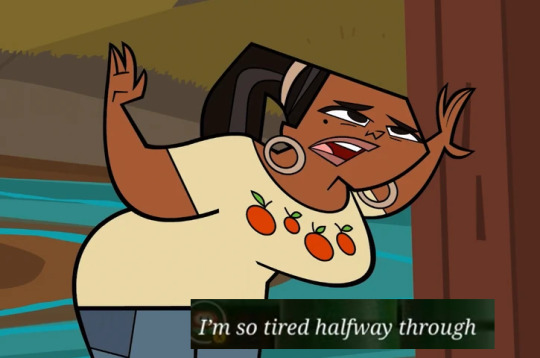
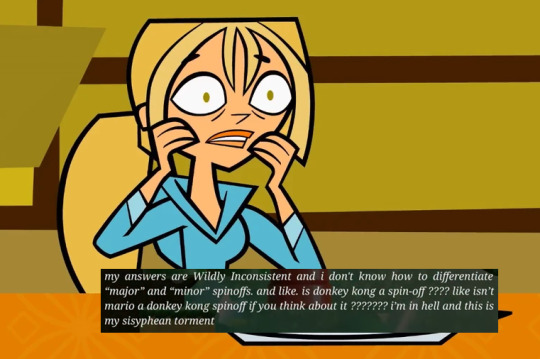

...So i promised myself i'd try to assign responses to the second Super Mario Game survey Jan Misali made to Total Drama characters. Here's the first couple!
#cheese posting#i tried so hard to make this a team victory thing but i didn't manage to U_U#finding the pic for the first one was annoying ngl. glad i thought of looking through the wiki article on specific episodes#im sorry i could not resist using that last one. it's perfect#td leshawna#td bridgette#td lindsay#total drama#total drama textposts#total drama memes#...should i directly mention jan misali in these posts. i don't know#i watched the full video before making this it is. sooooo in depth it's fascinating#pretty different vibe from the previous one too
241 notes
·
View notes
Text

was reading this article on ToughPigs about a trans puppeteer/performer and honestly shoutout both to Morgana Ignis for being brave enough to ask for her name to be changed and Brian Henson for insta-killing her deadname
bonus comment from the author:

#muppets#the muppets#trans#queer#outdesign posts things#can't recommend the full article enough#toughpigs always does great pride articles this time of year#greatest hits
2K notes
·
View notes
Text



“Edwin and Charles have died, but in a lot of ways they’ve never had to face that they’re dead,” creator Steve Yockey explains of the show’s ghostly duo. “And here comes this living teenage girl [Crystal] that upsets the applecart. All of a sudden everyone’s having to learn how to grieve for these experiences that happened a long time ago or face things about their lives they’ve put behind them but never really processed.”
#dead boy detectives#jayden revri#kassius nelson#yuyu kitamura#george rexstrew#steve yockey#beth schwartz#dbda articles#going to start working on getting articles up on here now too#posting a few clips so people will go and read the full thing
152 notes
·
View notes
Text
Beira’s Place: Thousands helped by Edinburgh rape centre set up by JK Rowling
A year on from the opening of JK Rowling’s women-only rape centre, thousands of victims have reached out for help.
A veteran of more than four decades protecting and sheltering women suffering sexual violence and domestic abuse, Isabelle Kerr was so passionate about supporting JK Rowling’s decision to fund a women-only centre that she came out of retirement to help set it up.
Speaking for the first time since Beira’s Place opened, Isabelle, 67, said: “The whole ethos of the place took me back to the grassroots of the women’s movement in Scotland, when women helped other women stay safe in an act of basic feminism.
“It was how women dealt with the practicalities brought about by the age-old problem of domestic abuse and sexual violence. I’m saddened to say very little has changed through the decades, which is why Beira’s Place has been busy from the moment we opened our doors.”
Isabelle said: “Men’s violence towards women continues unabated around the world. Justice systems continue to fail women with sentencing that rarely reflects the damage and trauma inflicted, despite these crimes carrying the possibility of a life sentence.
“We still have a culture where victims are blamed because of what they wear, where they went or what they did rather than holding the perpetrator to blame. It’s soul destroying.”
“Our phones started ringing the day we opened. They haven’t stopped. We’ve helped almost 2,000 callers looking for support. Over 250 survivors have used our safe space. Many told us they would not want to use the service if men were on the premises, either because they have been so traumatised or for cultural reasons.
Isabelle warns that much more needs to be done about identifying the escalating cycle of violence towards women. She said: “We don’t live in the kind of society where women and girls are safe from predators, stalkers, rapists and men who use coercive control to trap the vulnerable. We live in a society where women and girls have lost so much trust and hope in our criminal justice system that only 10% of violence and sex crimes are ever reported.
“Until we take these crimes more seriously, very little will change.”
611 notes
·
View notes
Text





8 July 2024.
186 notes
·
View notes
Text
GR96
@fusionspruntcityjournal

So how do you produce electricity with living plants? Simply by using the natural processes that already occur. In short: the plant produces organic matter via photosynthesis. Only part of this organic matter is then used for its own growth. The rest is excreted via the roots. Around the roots, bacteria feed on the organic matter and they release electrons. If you’re able to harvest the electrons into an electrode, you can couple the first electrode to a counter-electrode and build an electrical circuit, like in a battery. The electrons flow back into the natural system via the counter-electrode, so it’s completely circular. Because we use the natural processes around the plant, nature is not harmed. It works day and night, summer and winter. It only stops when the plant and its surroundings completely dry up or freeze over.
Sedum Oviferum
Sedum pachyphyllum is a ground-hugging succulent that spreads by rooting fallen stems and leaves. The succulent also goes by the names “Cerise Moonstones” or “Mauve Pebbles”. The short and stumpy round leaves have a light silvery-purple color; positioned at a right angles to the stem and curve upward, which in the wintertime, the tips of said leaves will turn into a notorious red.
Sedum Oviferum is a succulent that is very easy to grow and maintain. It is a resilient plant that can tolerate drought, moist and dry soils, and when given adequate exposure to sunlight and sufficient water, Cerise Moonstones will thrive outdoors. The Sedum Oviferum succulent grows at its best with regular exposure to sunlight. If Mauve Pebbles are planted in an area in a garden that gets plenty of sunlight per day, you will be rewarded with bright coloured leaves and flowers. In winter and early spring, Cerise Moonstones actively grow and produce blooms featuring red-orange petals and sepals that have the same pigmentation as the leaves. The flowers produced by Cerise Moonstones have a bell shape and a sugary fragrance.
Subterranean Clover
Trifolium subterraneum is also known as the subterranean clover (often shortened to sub clover), or subterranean trefoil. The plant's name comes from its underground seed development, a characteristic not possessed by other clovers. It can thrive in poor-quality soil where other clovers cannot survive.
This species is self-fertilizing, unlike most legume forage crops such as alfalfa and other clovers, which are pollinated by insects, especially honeybees. It is also grown in places where the extreme ranges of soil type and quality, rainfall, and temperature make the variable tolerances of sub clover especially useful.
Functionality
GR96 are powered by any plant of choosing on their back pod (the one we are going to discuss has a giant Sedum Oviferum and multiple sub clovers to operate) which is held in place by five strong suction cups. They’re manufactured for community gardens (strictly only one per garden), but they can also be bought by high class citizens for private properties, though at a way bigger cost since they’re financed by the city.
They can use their hands as scissors, shovels, and for watering (hence the big forearms, for storing the water), the latter which they do by dipping their hands in a bucket, opening the valve on their forearms so they can fill them up and releasing the water from the pinholes on their palms. Their “eyes” are actually a screen that can show plenty expressions, but the two circles above that peripheral screen are the real environmental sensors. They also have the same sensors on their ankles for inspecting the lower plants and ground without the need of kneeling, and their feet are shaped in a way so that weight is evenly distributed, lowering the chances of damaging a plant if they were to step on it. The ear like protrusions are small solar panels, used as backup energy (they don’t have any communication properties). Their speaker aka their “voice” is the mohawk-like structure on the top (which also has their series barcode 128 on the lower back), but when they speak there are these strips at the sides of the face mask that light up with the volume. The mask (non removable) has a set of pipes that are used for analyzing the air quality and humidity of the area surrounding them.
#my art#fusionsprunt#fusionsprunt oc#fusionsprunt clover#i’ll reblog this again later with their lore and alt design#the sedum oviferum is a fictional succulent i came up with since i couldn’t find one that i liked lmao#literally said fuck it it’s my oc i make the rules#[slaps a giant plant inside]#the energy gathering segment is based on a real article!#in its current state it can only power small leds#but i like to imagine a future where that energy could power full fledged robots :0
191 notes
·
View notes